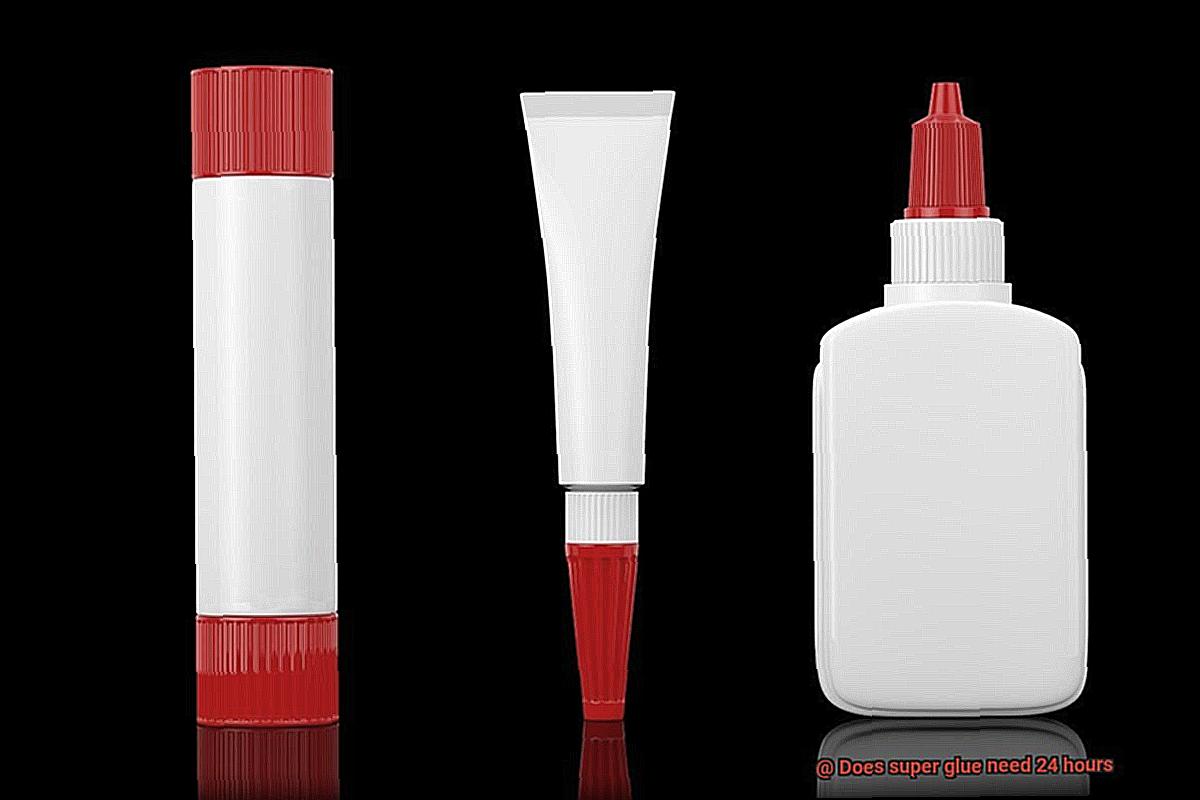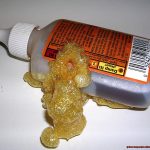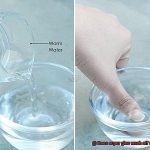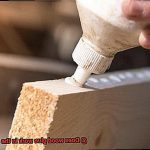You’re in the midst of fixing something, desperately reaching for that trusty tube of super glue. You apply it with precision, holding your breath as you wait for it to dry.
But here’s the burning question: does super glue really need a whopping 24 hours to set? Today, my fellow adhesive aficionados, we’re diving headfirst into this topic.
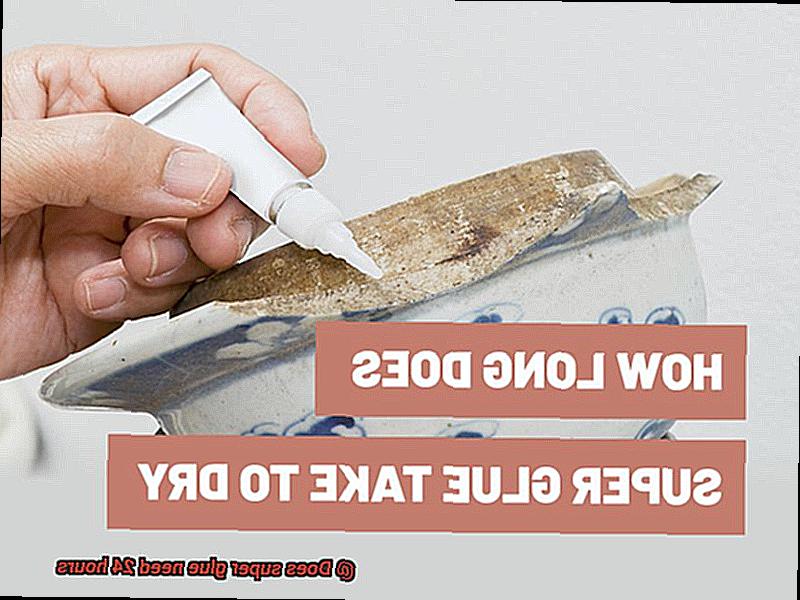
So grab yourself a steaming cup of joe, settle into your comfiest chair, and prepare to unveil the truth behind the optimal drying time for our beloved super glue.
What is Super Glue?
Contents
- 1 What is Super Glue?
- 2 How Long Does Super Glue Take To Cure?
- 3 Factors That Affect Curing Time
- 4 Recommended Curing Times for Different Brands of Super Glue
- 5 Quick-Curing Super Glues
- 6 Temperature and Humidity Effects on Curing Time
- 7 When to Allow Extended Curing Times
- 8 Alternatives to Super Glue
- 9 Conclusion
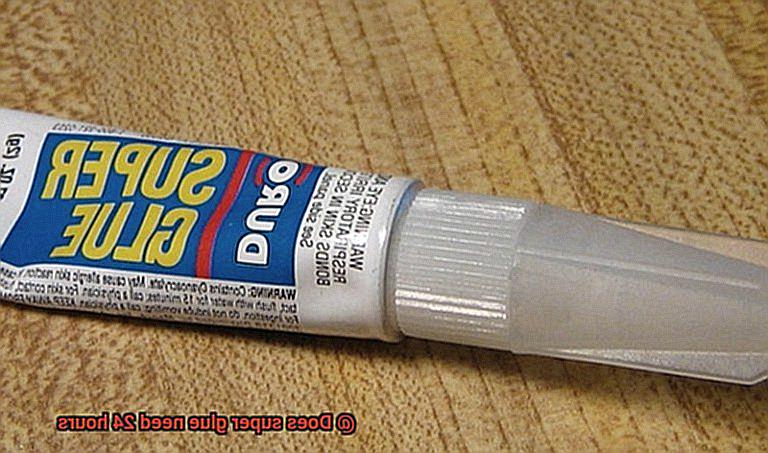
When it comes to adhesive solutions, few are as impressive as super glue. This remarkable substance, also known as cyanoacrylate adhesive, has the power to bond a wide range of materials together with incredible strength and speed.
Whether you’re repairing broken objects, fixing jewelry, or creating intricate crafts, super glue is an essential tool to have in your arsenal.
In this article, we’ll explore the properties and uses of super glue, shedding light on why it has become a beloved adhesive for both professionals and DIY enthusiasts.
The Chemistry Behind Super Glue:
Super glue’s secret lies in its main ingredient: cyanoacrylate. When exposed to moisture, cyanoacrylate undergoes a rapid chemical reaction that causes it to polymerize and harden. This means that once you apply super glue to a surface, it starts bonding almost instantly. The speed and strength of this reaction are what make super glue so powerful and effective.
Versatility at Its Finest:
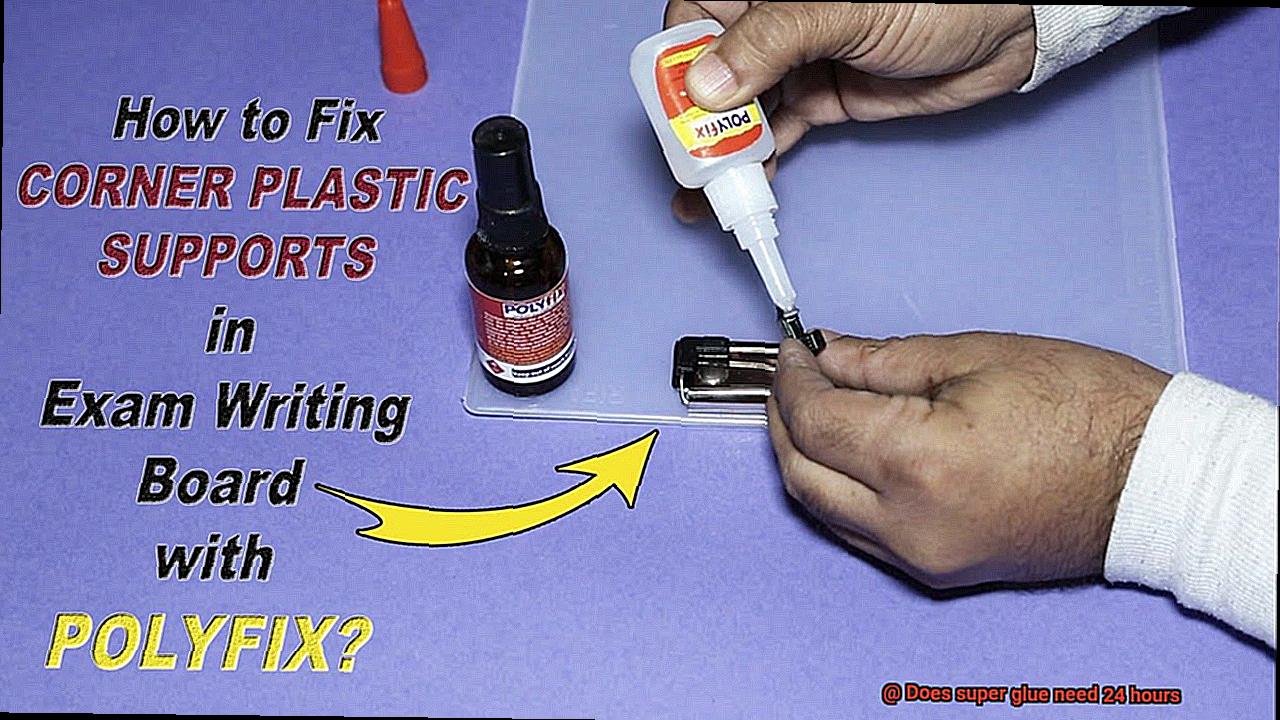
One of the greatest advantages of super glue is its versatility. It can bond a variety of materials together, including plastic, metal, wood, ceramics, glass, and even skin. Whether you’re fixing a broken vase or creating a piece of jewelry, super glue is the go-to solution for countless applications.
It’s like having a universal adhesive that can tackle any bonding challenge you throw at it.
Different Forms for Different Needs:
Super glue comes in various forms to suit different bonding requirements. Liquid super glue is the most common type and is ideal for precise applications. Its thin consistency allows for easy application and quick drying times.
Gel super glue, on the other hand, has a thicker consistency and is perfect for vertical or porous surfaces where traditional liquid glue may run or seep through. For quick and even application over large areas, spray super glue in aerosol cans offers convenience and ease.
Limitations to Consider:
While super glue is undoubtedly impressive, it does have some limitations. It may not be suitable for use on certain surfaces like fabric or rubber since it may not bond effectively. Additionally, removing dried super glue can be challenging, so it’s important to exercise caution during application. It’s best to read and follow the manufacturer’s instructions carefully to ensure successful bonding and avoid any mishaps.
How Long Does Super Glue Take To Cure?
Super glue, also known as cyanoacrylate adhesive, is a lifesaver when it comes to bonding materials together quickly and securely. But how long does it take for this powerful adhesive to fully cure? Let’s dive into the details to find out.
The curing time of super glue can vary depending on several factors. Firstly, the type of super glue being used plays a significant role. Different brands and formulations may have different curing times, so it’s always wise to check the product label for specific instructions.
In general, super glue can start to set within seconds of application. That means you’ll need to work quickly to get your materials in place before the glue begins to bond. Within a few hours, the bond should reach its full strength, making it suitable for most applications.
However, it’s essential to understand that “cure” can have different meanings in this context. While the adhesive may become strong enough for most purposes within a few hours, it may take longer for it to fully harden or reach its maximum durability. For optimal results, it’s best to wait at least 24 hours before subjecting the bond to heavy loads or extreme conditions.
The curing time of super glue can also be influenced by environmental conditions. Higher temperatures generally accelerate the curing process, while lower temperatures can slow it down. Similarly, low humidity levels may prolong the curing time. So if you’re working in a cold or dry environment, you might need to exercise a little patience and give the adhesive some extra time to cure properly.
To speed up the curing process, some manufacturers offer accelerators or primers designed for use with super glue. These products can help promote faster bonding and reduce waiting time. If you’re in a hurry or working on a time-sensitive project, using an accelerator or primer can be a great option.
Factors That Affect Curing Time
In this comprehensive guide, we will delve into the captivating world of super glue and uncover the factors that influence its curing time. So grab a cup of coffee and prepare to become an expert on all things glue.
Material Type:
The type of material being bonded is a major player in the curing time of super glue. Different materials possess varying levels of porosity, which impact how quickly they absorb moisture from the glue. Porous surfaces like wood may require more time to dry, while non-porous materials like plastic or metal tend to dry faster.
Humidity:
Humidity is another critical factor that can significantly influence the drying time of super glue. Cyanoacrylate adhesives rely on moisture in the air to kickstart the curing process. Higher humidity levels can expedite drying time, while low humidity can slow it down. So if you reside in a humid environment, expect your glue to dry at lightning speed.
Temperature:
Just like Goldilocks and her porridge, temperature plays a pivotal role in achieving the perfect curing time. Warmer temperatures accelerate the drying process, while colder temperatures put it on hold. However, beware of extreme heat as it can cause the glue to cure too quickly, potentially compromising its bond strength.
Bond Thickness:

Are you bonding large surfaces or creating thick layers of glue? Then brace yourself and allow some extra time for a full cure. Thicker layers take longer to dry compared to thinner ones. Patience is key here – rushing through the process may result in a weaker bond.
Freshness of Glue:
Super glue is not immortal; it has a shelf life. Using fresh glue guarantees optimal curing capacity. If you notice that your glue is not drying within the expected timeframe, check the expiration date on the packaging.
Recommended Curing Times for Different Brands of Super Glue
Super glue, also known as cyanoacrylate adhesive, is a powerful bonding agent that can quickly join materials together. However, it’s important to allow sufficient time for the glue to fully cure to ensure maximum strength and durability. In this blog post, we will explore the recommended curing times for different brands of super glue, so you can achieve optimal results in your projects.
Let’s start with Gorilla Glue, a popular brand known for its robust adhesive properties. For most applications, Gorilla Glue recommends a clamping time of 1-2 hours. However, if you want the glue to reach its maximum strength, it’s best to let it cure for a full 24 hours. This may seem like a long wait, but patience pays off when it comes to achieving the strongest bond possible.
Moving on to Loctite, another renowned brand of super glue, the curing time can vary depending on the specific product. In general, Loctite suggests allowing 24 hours for their super glue to fully cure. However, some of their instant adhesive range can work their magic in as little as a few seconds. Yes, you read that right – seconds. But before you get too excited about lightning-fast drying times, keep in mind that factors like temperature and humidity can influence the process.
Temperature and humidity play a significant role in how quickly super glue sets. Higher temperatures generally speed up the curing time, while colder temperatures can slow it down. Similarly, high humidity levels can accelerate the process, whereas low humidity levels may prolong it. So be mindful of these environmental factors when working with super glue.
Now, what about other brands of super glue? Each brand has its own unique formulation and recommended curing times. It’s crucial to refer to the manufacturer’s instructions for specific guidelines. By following their recommendations, you’ll ensure that you’re giving the glue enough time to cure properly.

Quick-Curing Super Glues
Imagine this: you’re in the middle of a time-sensitive repair project, and waiting hours for your glue to dry simply won’t cut it. You need an adhesive that can provide a rock-solid bond in seconds, not hours. Enter quick-curing super glues – the superheroes of adhesives that work their magic in the blink of an eye.
So, how exactly do these miracle glues work? It’s all about polymerization, a fascinating process that will make your jaw drop. When you apply quick-curing super glue to a surface, it reacts with moisture in the air or on the substrate, causing it to harden and form an unbreakable bond. It’s like witnessing a spellbinding magic trick unfold right before your eyes.
The greatest perk of quick-curing super glues lies in their ability to deliver an instant bond. Gone are the days of twiddling your thumbs while waiting for glue to dry or struggling with clamps to hold everything together. With these glues, it’s as simple as applying the adhesive, pressing the surfaces together, and voila. Your project is good to go.
But here’s the catch: while quick-curing super glues set rapidly, they may not reach their full strength within the first 24 hours. Patience is key, my friend. To achieve the strongest and most durable bond possible, follow the manufacturer’s instructions diligently. Different brands and types of quick-curing super glues have their own unique curing times and strength development properties.
To ensure your bond reaches its maximum strength, resist the temptation to subject it to excessive stress or load during the initial curing period. I know it’s hard to resist testing out your newly glued creation right away, but trust me – patience will pay off in spades.
Remember, each quick-curing super glue has its own set of characteristics and curing times. Some brands boast faster curing times than others, so be sure to read and heed the manufacturer’s instructions. This way, you’ll achieve top-notch results and be able to rely on your adhesive for all your bonding needs.
Temperature and Humidity Effects on Curing Time
These caped crusaders of the glue world possess the power to work their magic in mere seconds, creating an unbreakable bond that defies the constraints of time itself.
But how do these extraordinary glues accomplish such remarkable feats? It all comes down to polymerization, a mind-bending process that will leave you awestruck. When you apply quick-curing super glue to a surface, it reacts with the moisture in the air or on the substrate, causing it to harden and form an indomitable bond. It’s akin to witnessing a mesmerizing illusion unfold before your very eyes.
Now, here’s the catch: temperature and humidity can significantly affect the curing time of super glue. If you find yourself working in a cold environment, brace yourself for a lengthier wait as the glue takes its time to cure. On the other hand, high humidity can impede the process, resulting in a weaker bond. So, it’s crucial to discover the sweet spot where optimal conditions prevail.
Ideally, you want to operate in an environment where temperature and humidity levels are moderate. Consider a temperature range between 60°F (15°C) and 75°F (24°C), coupled with a relative humidity level between 40% and 60% – these conditions are generally suitable for most super glues. However, bear in mind that different brands and types of super glue may have specific recommendations; always consult the manufacturer’s instructions.
Now, if you happen to find yourself in high humidity or low-temperature conditions, don’t fret. There are a few tricks up your sleeve to expedite the curing process. You could gently warm up the surrounding area using a hairdryer set on low heat or reduce moisture by employing a dehumidifier or positioning a fan near the glued surface.
But, beware. Excessive heat or airflow can cause complications, so always adhere to safety precautions. And remember, grant the glue ample time to fully cure before subjecting it to any stress or load – patience is the key to achieving unparalleled strength and durability in your bond.
When to Allow Extended Curing Times
Super glue is renowned for its rapid bonding capabilities, but there are instances where it requires additional time to reach its full potential. This article explores when it is advantageous to allow extended curing times for super glue, ensuring a robust bond that can withstand any challenge.
Bonding Porous Materials:
When working with porous materials like wood or ceramics, the absorption of super glue can impede the drying process. Patience is key in these situations, as allowing the glue to cure for at least 24 hours enables it to penetrate deep into the pores and establish a strong bond that stands the test of time.
Large or Heavy Objects:
For bonding large or heavy objects such as furniture or metal pieces, rushing the curing process is ill-advised. Similar to expecting a sprinter to win a marathon, subjecting an insufficiently cured bond to weight and pressure will result in failure. Allowing the glue ample time, preferably 24 hours or more, ensures maximum holding power and durability.
Specialized Formulations:
Not all super glues are equal, particularly those containing cyanoacrylate which forms a robust bond through moisture reaction. These formulations often require a minimum curing time of 24 hours for optimal results. Adhering to these guidelines unlocks the full potential of the glue and produces the strongest bond possible.
Temperature and Humidity:
Environmental conditions play a significant role in super glue’s curing time.
Lower temperatures and higher humidity levels slow down drying, necessitating consideration of these factors. Aim for an ideal temperature range of 60°F to 75°F with a relative humidity between 40% and 60% to ensure optimal curing.
If expedited drying is necessary, gentle warmth or reduced moisture may be employed, but always exercise caution and allow sufficient curing time.
Alternatives to Super Glue
You’re in luck. There are several options out there that can cater to your specific needs. Whether you’re a DIY enthusiast, a craft lover, or just someone who’s tired of dealing with the sticky mess of traditional super glue, these alternatives will surely come in handy.
First up, we have epoxy adhesive. This stuff is like the superhero of adhesives, ready to save the day in construction and automotive repairs. Known for its strong bond and versatility, epoxy adhesive is perfect for heavy-duty tasks that require a reliable fix.
If you’re more into quick fixes and small projects, cyanoacrylate adhesive, also known as “crazy glue,” might be your go-to. With different formulations and drying times available, this adhesive offers similar properties to super glue but with added flexibility for your specific needs.
Now, let’s talk about wood. If you’re a woodworking enthusiast or simply need to bond some wooden pieces together, carpenter’s glue or wood glue is the way to go. This specialized glue is designed for woodworking projects and provides a strong bond that’ll last.
But what about materials that require a little extra love? That’s where two-part adhesives like polyurethane adhesive come in. These adhesives consist of a resin and a hardener that need to be mixed together before application. They’re great for bonding materials like metal or plastic, giving you a strong and durable bond every time.
For all you flexible material lovers out there, silicone adhesive is your new best friend. It’s perfect for sealing and bonding flexible materials and provides a waterproof bond that won’t let you down. Whether it’s fixing a leaky shower or crafting something with fabric or rubber, silicone adhesive has got you covered.
And let’s not forget about specialized adhesives. Fabric glue for textile repairs, plastic cement for bonding plastic materials – there’s an adhesive for every purpose. These specialized options ensure that you have the right adhesive for the job, no matter what material you’re working with.
Also Read: How Long Does Super Glue Take to Dry?
Conclusion
In summary, the drying time of super glue is not set in stone. It depends on several factors that can influence its curing process. While it may start to set within seconds, experts recommend giving it a solid 24 hours before putting it under heavy stress or exposing it to extreme conditions. This allows the glue to fully harden and achieve its maximum strength.
Environmental conditions play a significant role in how long super glue takes to dry. Higher temperatures can speed up the curing process, while lower temperatures can slow it down. Likewise, high humidity levels can expedite drying time, whereas low humidity levels may prolong it.
Different brands and formulations of super glue have their own specific curing times, so be sure to consult the product label for precise instructions. For example, Gorilla Glue suggests clamping for 1-2 hours and waiting a full day for maximum strength. Loctite advises allowing 24 hours for their super glue to fully cure.
The material being bonded is also a crucial factor to consider. Porous surfaces like wood typically require more drying time compared to non-porous materials such as plastic or metal. Additionally, thicker layers of glue will naturally take longer to dry than thinner ones.
If you find yourself in a rush or working on a time-sensitive project, some manufacturers offer accelerators or primers specifically designed to speed up the curing process of super glue.
To sum it all up, patience is paramount when using super glue. By following the manufacturer’s instructions and taking into account environmental factors, you can ensure that your bond reaches its utmost strength and durability.

